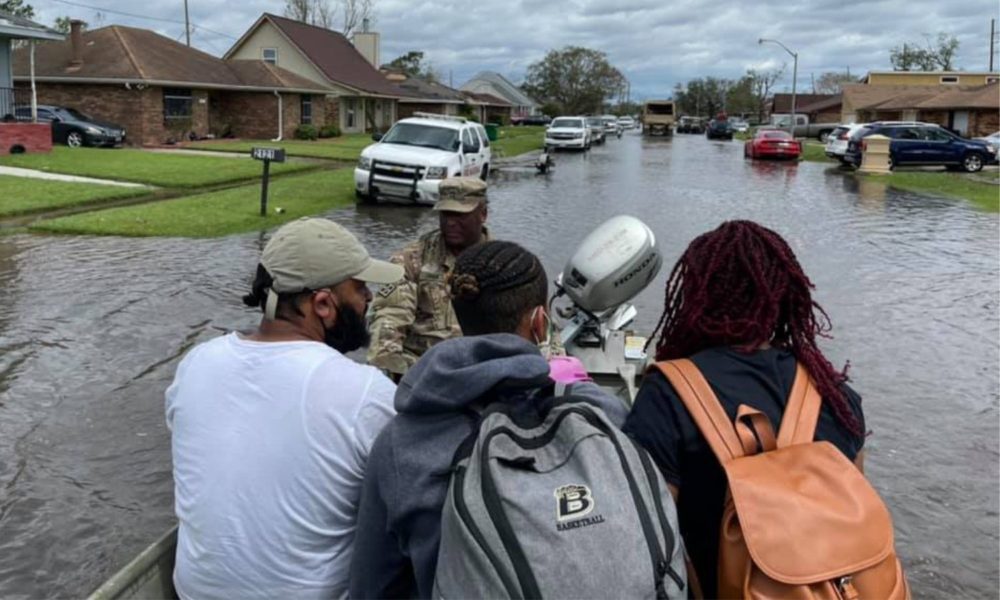After the devastating extreme weather and climate change-related impacts of 2020 (with 22 events exceeding a billion dollars and totaling $95 billion), the nation is again struggling to cope with these types of disasters in 2021, including record-breaking drought, wildfires, flooding and heat. Hurricane Ida ravaged its way from southern Louisiana as a Category 4 storm (endangering already stressed Covid relief efforts) up to New Jersey, New York, Pennsylvania, and Connecticut as a tropical storm. Estimated flood damages range from $16 billion (insured) to $24 billion (uninsured), and the death toll is estimated at 52 people in the Northeast, for a total of 82 lives lost from Ida. Then Tropical Storm Nicholas landed in Galveston, Texas, as a Category 1 hurricane, unleashing heavy rainfall up to ten inches in some areas and continued its way into Louisiana where it lingered, dumping more rainfall in the areas where communities are still reeling from Hurricane Ida. Many more rural, smaller communities are still suffering from power outages (or have only recently had their power turned back on), which multiplies the challenges of day-to-day life.
This is a “code red” moment for Congress. We swept past 2020 without any significant action to reduce emissions or increase resilience, all the while getting pounded by extreme events and besieged by even more devastating findings on the impacts of climate change. Additionally, communities across the nation are struggling from multiple and compounding impacts–from Covid-19 and the Delta variant to wildfires, smoke, and heat out west and flooding along the Eastern seaboard–and are in desperate need of resources to recover, particularly those communities who have been hit repetitively by extreme weather events and are historically disadvantaged. Studies find that many of these communities most in need of federal assistance don’t receive federal resources after a disaster.
Time is of the essence for Congress to act boldly to confront the climate crisis, both to reduce emissions and increase resilience. Currently the House is working on drafting the Build Back Better Act (the comprehensive House budget reconciliation legislation that contains pieces of President Biden’s Build Back Better agenda). Done right, this bill can be a historic milestone for–and down payment on–climate action. Here I cover the House Financial Services committee bill, just one of the 13 House committees that must draft legislation based on the budgeted amount the Budget Committee has allocated.
The House Financial Services Committee passed the Financial Services Committee Title of the Build Back Better Act, which if passed in the final bill, will go a long way to increasing the nation’s flood resilience. The section entitled “Strengthening Resilience Under National Flood Insurance Program”, would cancel the Federal Emergency Management Agency’s (FEMA) debt to the U.S. Treasury, help to calculate, map, and communicate flood risk, and help to close the flood insurance gap by establishing an affordability program. Here’s why these three policies are wise investments:
1. Cancelling FEMA’s debt to the US Treasury will redirect funds where they’re most needed
The bill would cancel FEMA’s roughly $20.5 billion debt to the U.S. Treasury. While this may give some folks pause, we must put the debt into context. In the past, FEMA was able to rely on premium payments to cover flood losses. However, the National Flood Insurance Program (NFIP) was never designed to handle the catastrophic flooding events that we’re seeing more frequently and that have been exacerbated by climate change. By law, FEMA is allowed to borrow money from the Treasury to help pay for its NFIP obligations if flood insurance premiums are insufficient to cover the damages. Over the years, Congress has authorized certain borrowing amounts. So why is forgiving FEMA’s debt to the U.S. Treasury a fiscally sound action? FEMA is required to pay interest on these borrowed funds. FEMA pays the U.S. Treasury over $400 million in interest annually (that’s more than FEMA’s whole budget for mapping), making it the third largest NFIP activity by cost. By maintaining this amount within the National Flood Insurance Fund (NFIF), FEMA can utilize such funds for where they’re actually needed.
2. Calculating, mapping, and communicating flood risk will help keep communities safe
Up-to-date and accurate flood maps are critical to every component of flood risk management and to the NFIP as a whole. FEMA flood maps influence local land use management, mandatory purchase of flood insurance, flood risk disclosure, and flood risk mitigation measures. Numerous entities have discussed the consequences of the inadequacies of FEMA’s flood maps, including the Congressional Research Service (CRS), the Office of Inspector General (OIG), the Association of State Floodplain Managers (ASFPM), and the Government Accountability Office (GAO). Frequently cited issues include the age, poor quality, lack of coverage of small tributaries, and incorporation of the latest science and future conditions.
In 2018 scientists released new research on flooding from heavy rainfall events and found that the U.S. exposure to serious flooding is approximately 2.6–3.1 times higher than previous estimates. That same study found that 41 million people are living within the 1% annual exceedance probability floodplain (aka the “100-year” floodplain), compared to only 13 million when calculated using FEMA flood maps. In fact, recent analysis finds that one in four residential homes (almost 4.3 million) across the country face substantial flood risk, and the cost of damages to these homes annually could be as high as $20 billion. When accounting for climate change, the number of homes at substantial flood risk is projected to grow 61 percent over the next 30 years with an estimated $32.3 billion in damages.
Congressional appropriation levels have been part of the problem. While the benefit of accurate maps cannot be overstated, the data needed to produce them, such as high-quality topographic data and flood elevations, is expensive to gather. Funding levels for flood mapping have been as low as $89 million in fiscal year 2013 and as high currently with an authorization of $400 million in annual appropriations. The ASFPM Flood Mapping for the Nation report projected the cost of completing mapping of the nation to be between $3.2 billion and $11.8 billion, with an annual maintenance appropriation of between $107 million and $480 million.
This House Financial Services Committee bill would authorize $3 billion in appropriations to FEMA for flood hazard mapping and risk analysis for FY 2022. This would be a historic and much needed investment to advance FEMA’s efforts on flood risk mapping. With this level of investment in flood hazard mapping, FEMA will have the resources it needs to incorporate future conditions, particularly climate change. FEMA began an initial outline of a Future Flood Hazard Mapping Program but hopefully with this level of funding, FEMA will ramp up its efforts on this front. FEMA’s flood hazard maps must incorporate the risks of heavy precipitation events and sea level rise, otherwise communities and government officials will make decisions based on outdated data that will be a recipe for failure. Congress should require that FEMA map all sources of flood risk and expand its flood hazard and risk data nationwide beyond the narrowly confined special flood hazard area (SFHA), and should require FEMA to broaden the mandatory purchase requirement to increase participation in the flood insurance program.
3. Closing the flood insurance gap (in part) with an affordability program will provide a safety net for those who need it most
According to Millman, only four percent of at-risk, single-family homes in the U.S. are protected by flood insurance today. While a flood insurance affordability program won’t close the flood insurance gap, it will help move the needle towards that goal and provide a flood insurance safety net for those who need it most. For some time, think tanks, policy, and science experts, FEMA, Congress, and local activists have been advocating for a flood insurance affordability program under the NFIP, for frontline communities who are most impacted by the inequities and lack of access to affordable insurance. To succeed, Congress needs to give FEMA the authority to establish an affordability program. In the last Congress, affordability provisions were included in three NFIP long-term reauthorization bills (H.R. 3167; S. 2187; and H.R. 3872) introduced into the House and Senate. With the House Financial Services Committee reconciliation bill, Congress does just this.
The House Financial Services Committee bill authorizes FEMA to establish a means-tested NFIP affordability program and would appropriate $1 billion to carry out the program over five years. The committee’s bill tasks the FEMA administrator to issue interim guidance within two years on how she will implement the flood insurance affordability program. After so much research and advocacy for a flood insurance affordability program, this provision is another historic moment for NFIP, flood resilience, and frontline communities. We look forward to providing FEMA with guidance as the agency works to develop the NFIP affordability guidance and rulemaking.
This provision is particularly timely to help round out and advance FEMA’s “equity in action” objective for Risk Rating 2.0–the new national flood insurance property level risk rating system. FEMA can then design and implement an affordability program to help low-income households afford flood insurance coverage and reduce their flood risk, especially for those who may see their insurance rates rise due to the new rating system (see RR 2.0 state level information). FEMA will also need to pay special attention as to how to assist renters, affordable multifamily housing, and mixed-use buildings as it designs the flood insurance affordability program.
Urgently needed, cost effective, and smart policies must pass to increase flood resilience
We urge Congress to include these flood resilience provisions in the final reconciliation bill. Our communities need accurate information and resources to recover after repetitive, extreme weather events. Communities, particularly historically disadvantaged communities, simply can’t afford to continue to be misled by bad flood mapping information or by the inability to afford a simple flood insurance safety net. While Congress will need to do more after the House reconciliation and the Senate infrastructure bills, including reforming and reauthorizing the NFIP, these three provisions will go a long way to furthering flood risk resilience nationwide.

